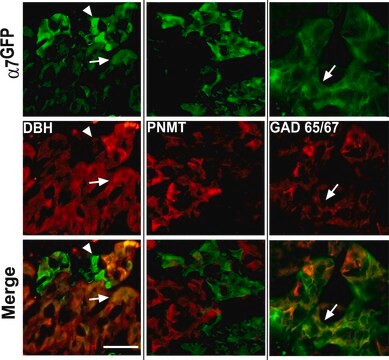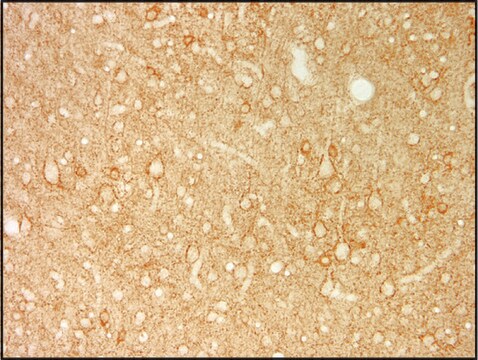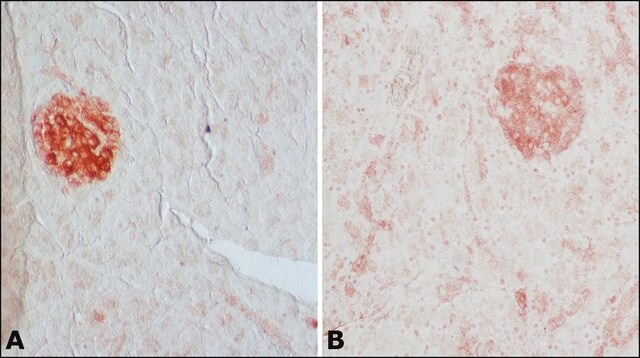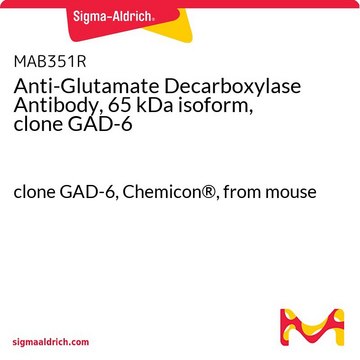MAB351
Anti-Glutamate Decarboxylase Antibody, 65 kDa isoform, clone GAD-6
clone GAD-6, Chemicon®, from mouse
Sinónimos:
GAD65
About This Item
Productos recomendados
biological source
mouse
Quality Level
antibody form
purified immunoglobulin
antibody product type
primary antibodies
clone
GAD-6, monoclonal
species reactivity
rat, human
manufacturer/tradename
Chemicon®
technique(s)
immunohistochemistry: suitable
western blot: suitable
isotype
IgG2a
NCBI accession no.
UniProt accession no.
shipped in
dry ice
target post-translational modification
unmodified
Gene Information
human ... GAD2(2572)
General description
Specificity
Immunogen
Application
Western blot
Optimal working dilutions must be determined by end user.
APPLICATION NOTES FOR MAB351
IMMUNOHISTOCHEMISTRY
1) Perfuse rats with 100 mM phosphate buffer, pH 7.4 containing 1% paraformaldehyde, 0.34% L-lysine and 0.05% m-periodate (1% PLP).
2) Postfix brains in 1% PLP for 1-2 hours.
3) Transfer brains to 100 mM phosphate buffer containing 30% sucrose and gently agitate on a shaker platform at +4°C for 48-60 hours.
4) Using a sliding microtome, cut 30 mm sections of frozen cerebellum. As the sections are cut, collect them in a vial of cold 100 mM phosphate buffer.
5) Incubate sections in PBS containing 1.5% normal serum and 0.2% Triton X-100 for 30 minutes.
6) On a shaker platform, incubate sections with MAB351 (diluted 1 μg/mL in PBS containing 1.5% normal serum and 0.2% Triton X-100) for 12-36 hours at +4°C.
7) On a shaker platform, rinse sections eight times, 10-15 minutes per rinse, in PBS.
8) Detect with standard secondary antibody detection system (PAP, ABC, etc.).
9) Mount sections, dehydrate, and apply coverslips.
Neuroscience
Neurotransmitters & Receptors
Target description
Physical form
Storage and Stability
Analysis Note
Rat brain tissue
human brain lysate
Other Notes
Legal Information
Disclaimer
¿No encuentra el producto adecuado?
Pruebe nuestro Herramienta de selección de productos.
Optional
signalword
Warning
hcodes
Hazard Classifications
Acute Tox. 4 Dermal - Acute Tox. 4 Inhalation - Acute Tox. 4 Oral - Aquatic Chronic 3
Storage Class
13 - Non Combustible Solids
wgk_germany
WGK 3
flash_point_f
Not applicable
flash_point_c
Not applicable
Certificados de análisis (COA)
Busque Certificados de análisis (COA) introduciendo el número de lote del producto. Los números de lote se encuentran en la etiqueta del producto después de las palabras «Lot» o «Batch»
¿Ya tiene este producto?
Encuentre la documentación para los productos que ha comprado recientemente en la Biblioteca de documentos.
Nuestro equipo de científicos tiene experiencia en todas las áreas de investigación: Ciencias de la vida, Ciencia de los materiales, Síntesis química, Cromatografía, Analítica y muchas otras.
Póngase en contacto con el Servicio técnico






